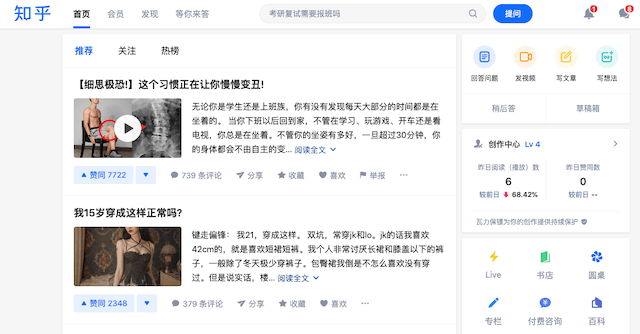Launched in 2011, Zhihu is the largest Q&A online community and one of the top five comprehensive online content communities in China, both in terms of average mobile MAUs and revenue in 2020, according to CIC.

Zhihu is also recognized as the most trustworthy online content community and widely regarded as offering the highest-quality content in China, according to the CIC Survey.
It prides itself as a “marketplace of answers,” steadily accumulating trustworthy content through continuous creation and engagement among users and content creators over a journey of more than ten years.
As of December 31, 2020, Zhihu had 43.1 million cumulative content creators, who had contributed 315.3 million questions and answers. Its 75.7 million average MAUs in the fourth quarter of 2020 generated 675.7 million average monthly interactions during the same period.
Though it’s launched for 10 years but it is still in an early stage of monetization. Its average MAUs increased from 48.0 million in 2019 to 68.5 million in 2020.
It has adopted a content-centric monetization model and currently generates revenue from online advertising (62.4% of total revenues in 2020), paid membership (23.7%), content-commerce solutions (10%), and other new services (3.9%; primarily online education and e-commerce services).
Zhihu primarily charges display-based advertisements by cost-per-day (“CPD”) model and cost-per-mille (“CPM”) model, and primarily charge performance-based advertisements by cost-by-click (“CPC”) model.
Zhihu’s revenue increased from RMB670.5 million in 2019 to RMB1.4 billion (US$207.2 million) in 2020. Its net loss decreased from RMB1.0 billion in 2019 to RMB517.6 million (US$79.3 million) in 2020.
Its average MAUs increased by 42.7% from 48.0 million in 2019 to 68.5 million in 2020.
The level of user engagement in our community is also increasing, according to Zhihu IPO prospectus. The number of its average monthly social interactions in 2020 increased by 42.0% compared to that in 2019, and the daily active users opened the Zhihu app an average of 6.2 times per day in the fourth quarter of 2020.
Its average monthly paying members increased significantly from 0.6 million in 2019 to 2.4 million in 2020, and our paying ratio increased from 1.2% to 3.4%. In addition, the growth of its user base and user engagement has attracted more merchants and brands to our community and increased their spending to pursue more effective branding and advertising.
In addition to online advertising and paid membership services, Zhihu formally launched content-commerce solutions in early 2020. It has also consistently explored additional content-centric monetization channels and added new revenue streams.
For example, in furtherance of its development of education vertical, Zhihu has launched an online education service in response to the high demand for educational resources of its users. It has added e-commerce service as part of its efforts to expand the vertical service coverage in response to the significant consumption of trustworthy content on product recommendation and evaluation in the community.
43.1% of Zhihu users are female as of December 2020. They also have a wide geographical coverage with 52.6% of users in tier 1 and new tier 1 and 21.2% of MAUs in tier 2 cities in China as of December 2020.
In addition, 78.7% of Zhihu’s MAUs were under 30 years old in December 2020.
Users can leverage a series of features to engage actively within the community. Users can upvote and downvote answers and comments, which serve an instrumental role in our community interactions.
Users can also identify and invite other users to answer any question in the community. Other social interaction features include comments, private messages, likes, follows, favorites, and sharing.
Fake fans and manipulations on China social media
Zhihu Content Operations
Zhihu uses an AI-powered question routing system to invite users to answer questions that correspond to their interests and expertise, to incite their desire to create.
It also offers productivity tools to help content creators efficiently produce quality content. It uses a feed recommendation system and a search system to distribute content of interest to users.
Users can browse their personalized home feeds on the Zhihu app and website based on their profiles and prior behaviors, as well as search keywords to quickly access relevant content.
In addition, users can see updates from content creators and topics that they have followed, read trending topics, watch videos, and browse channels to discover content.
Zhihu leverages TopicRank algorithms to assess the content based on analytical results of users’ credentials and engagement. As a result, users’ behavior ultimately determines the order by which content is presented.
Influential, reputable, and well-recognized users generally have more weight in the content assessment process. It uses big data analytics to study user interactions and other factors to refine its assessment of the appropriateness of any particular content and determine corresponding reactions.
To respond to inappropriate content, it uses AI-powered proprietary systems, such as WaLi, content-monitoring system, and WuKong, anti-spamming system.
eBook: Win Chinese Market with Content
Zhihu Founder

Its founder, chairman, and chief executive officer, Zhou Yuan, born in 1980 in Guizhou, is an entrepreneur with over 15 years of experience in the internet and media industries.
Its shareholders include Tencent, Kuaishou, and Baidu.
As of December 31, 2020, Zhihu had 1,651 full-time employees, all of whom were based in China, primarily at our headquarters in Beijing, China.
China’s online content communities
The market size of China’s online content communities in terms of revenue increased from RMB38.6 billion in 2015 to RMB275.8 billion in 2019, and is expected to increase to RMB1.3 trillion in 2025, representing a CAGR of 30.3% from 2019, outgrowing the overall online content market.
Online content community user base in China has expanded significantly from 516.2 million in 2015 to 773.0 million in 2019, and is expected to further increase to 1.0 billion in 2025.
China’s online content community market is still at early stage of monetization with significant growth potential.
Revenue per user of China’s online content communities, calculated as total revenue of online content community market divided by total number of users, was RMB356.7 in 2019, growing fivefold since 2015, but only about one-third of that of the U.S. market in 2019, which was RMB1,024.3.
In 2025, this value in the China market is expected to further increase to RMB1,292.4, which is still lower than the RMB1,858.6 expected for the U.S. market, showing significant potential for monetization.
Compared with the U.S. market, where monetization is primarily through advertising, China’s online content community market features more diversified monetization channels, including online advertising, paid membership, content-commerce solutions, content e-commerce, virtual gifting in live streaming, online games, IP-based monetization, and online education.
China’s online content communities can be further categorized into comprehensive online content communities and vertical online content communities.
Comprehensive online content communities refer to content communities covering news, entertainment content, experience sharing, professional expertise, and knowledge, among others.
Vertical online content communities refer to communities that provide content in certain content verticals, such as cosmetics and games, among others.
According to CIC, the market size of comprehensive online content communities in China in terms of revenue has expanded rapidly from RMB3.2 billion in 2015 to RMB121.2 billion in 2019, and is expected to reach RMB943.5 billion in 2025, representing a CAGR of 40.8% from 2019, higher than that of the overall online content community market in China.
The trend suggests that Chinese users tend to favor one-stop destinations for a comprehensive set of content offerings, as oppose to vertical online communities.
The diversity of content verticals of comprehensive online content communities enables them to satisfy the diverse needs of a broad user base. Users are able to utilize one app for different scenarios to optimize their experience, which enhances user stickiness.
Among online content formats, text and image are usually the origination and foundation of content creation, providing comprehensive content coverage and flexible content consumption scenarios, whereas video has become an increasingly popular form of content creation and consumption.
In terms of content products, Q&A form by nature invites a high level of user interaction and inspires sharing of knowledge, experience, and insights. Platforms with multiple content forms can cater to diverse user needs, and therefore have better receptivity among users and higher monetization potential.
The number of paying users in China’s online content communities, or users who pay for any type of products or services such as membership, education, and virtual gifts in online content communities at least once during a year, is expected to increase at a CAGR of 17.1% between 2019 and 2025, which means an increase of 360.4 million extra paying users of online content communities to 588.2 million in 2025.
Over 80% of surveyed users are willing to pay more for high-quality online content in the future, according to the CIC Survey.
According to CIC, China’s paid membership market size in terms of revenue reached RMB105.0 billion in 2019 and is expected to grow to RMB328.3 billion in 2025, among which the revenue generated from online content communities is expected to increase from RMB17.4 billion in 2019 to RMB90.2 billion in 2025.
Within China’s paid membership market, online content communities are expected to outgrow other online content market players due to the higher potential of membership penetration and lower content cost to ramp up paid membership.
KFC & Ting Hsin’s attempts in membership e-commerce in China